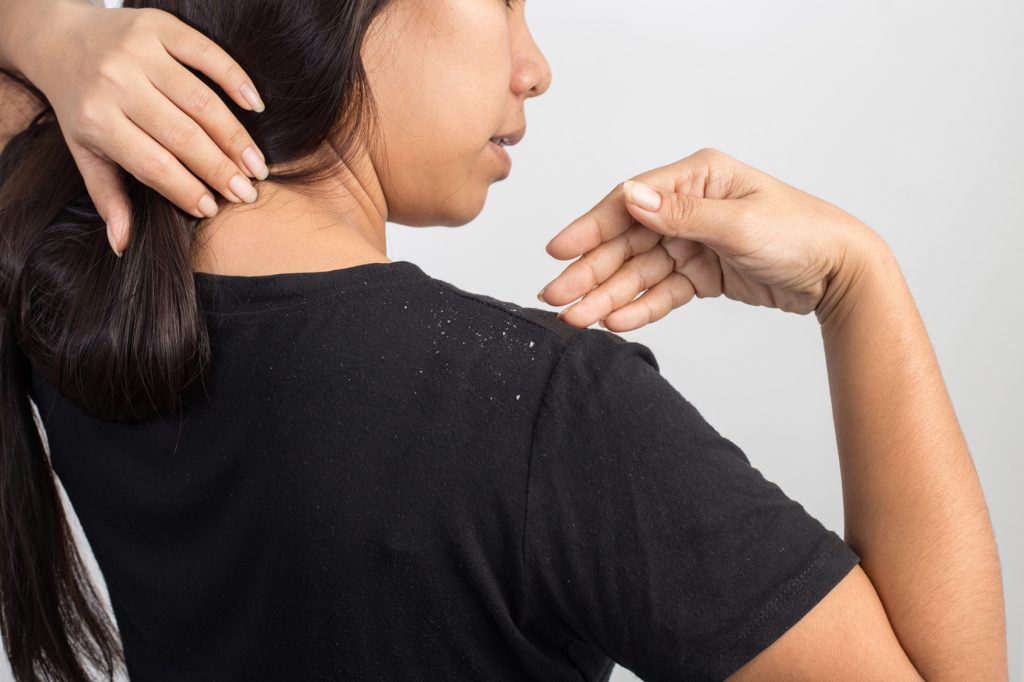Treating dandruff: A medical approach
Dandruff can be controlled with the help of a dermatologist, a diagnosis is the first step towards a healthy flake-free scalp.

What causes dandruff?
There are a number of possible causes for a scaly scalp. Contrary to the stigma, dandruff is not caused by poor hygiene. In most instances, dandruff is caused by dry hair and dry scalp, leading to excessive shedding. In this case, it will worsen seasonally with flare-ups during the winter months.
Seborrhoeic dermatitis: Dandruff is sometimes caused by a condition called seborrhoeic dermatitis, an inflammatory skin condition that also affects the scalp (Seborrhoeic Capitis). Seborrhoeic dermatitis of the scalp presents with a range of symptoms from a mild flaky scalp to a thick greasy yellowish scale that may cover the whole scalp.
Malassezia infection (closely linked to Seborrhoeic Dermatitis): Another cause of dandruff lies in the naturally occurring yeast microbes (Malassezia) that form part of the scalp. Due to an overproduction of sebum, they flourish and overpopulate. This leads to irritation, as mentioned above, which also causes flaking and shedding of yellow scabs or white flakes of skin.
Contact dermatitis: Recurrent use of skin and hair products may cause inflammation or irritability to the scalp leading to dandruff. Also, the use of hair extensions (weaves, artificial extensions) has been shown to have a direct relationship with an itchy and scaling scalp. It is important to tell your dermatologist about all of the products you use in your hair and on your body.
Underlying skin and hair conditions that cause a scaling of the scalp:
Tinea Capitis (scalp ringworm): Localised areas of scale to affected patch. Commonly seen in children but Tinea Capitis can also be seen in adults.
Eczema: Dry itchy white scale, affecting the entire scalp. The patient can have isolated scalp eczema or other lesions of eczema elsewhere on the body.
Psoriasis: A common condition that causes a dry thick silvery adherent scale especially along the hairline and above the ears. This can affect the whole scalp and flakes can be seen on the shoulders and on clothes.
Without addressing the underlying cause, the condition may persist and grow in severity. Underlying conditions may also worsen if they are left undiagnosed, which is why it is important to get a diagnosis.
Oleic acid sensitivity: Dandruff is not hereditary, although the sensitivities which cause dandruff may be hereditary. While everyone’s scalp produces oil, some people may have an excess of it. As this sebum breaks down, it forms oleic acid. This is a natural and healthy process, but it is very common for people to have a sensitivity towards oleic acid – up to 50% of people will react to it! As a result, the scalp may become itchy and inflamed. In order to remedy the irritation, your scalp will shed and regenerate faster than it should, leading to a build up and shedding of dead skin cells – dandruff flakes.
What are the symptoms of dandruff?
While conditions like dandruff have common symptoms that most people share, it’s not to say that everyone will have the same experience. Some people may only have one symptom while others may have them all. It is important to see a dermatologist, like Dr Khoza, to get an accurate diagnosis.
- Dandruff may present in an itchy and dry scalp that sheds excessively. Those battling with dandruff will be aware of white flakes of skin on the scalp, in the hair and on the shoulders.
- There are thickened areas of the skin, scalp, and hair.
- Other areas of the body may also be affected especially if the patient has Seborrhoeic Dermatitis, Psoriasis or Eczema. The nose, the eyebrows, the hairline, the ears, and the centre of the chest or back may all show excessive shedding of skin.
- In babies, most commonly newborns, dandruff is common and presents as a scaly yellow flaking on the scalp. It’s known as cradle cap (seborrhoeic capitis) and is generally harmless, self-correcting in the first year of life without treatment.
How dandruff is treated
While it is important to keep to a good washing routine, beware of drying out the scalp as this will lead to further irritation and exacerbate the problem. Wash the hair regularly (around 2-3 times per week) to prevent oil build-up and use products that are approved by a dermatologist.
As with all conditions, people’s reaction to treatments may vary. Some may find great results with one approach while others have a better effect with another. The typical treatments which deliver positive results include haircare shampoos containing:
- Coal tar – to slow the regeneration and shedding of skin cells.
- Selenium sulphide/zinc pyrithione – to reduce fungal growth and slow down cell turnover to reduce build-up and shedding.
- Salicylic acid – exfoliate dead skin cells before they build up and shed.
- Ketoconazole or Ciclopirox olamine – an antifungal treatment to reduce the growth of Malassezia.
What to expect from your appointment
We will examine the scalp and the rash – if there is one. We will ask you questions about the condition, including how long you’ve been experiencing the symptoms, what triggers you’ve noticed – like seasonal changes, whether you have a family history of dandruff and what hair care products you are using.
Dr. Khoza may decide to perform a scalp biopsy. To perform the biopsy, she will take a sample of the scalp to be examined under a microscope. This will rule out fungal infections, psoriasis, lupus and other skin disorders like dermatitis.
If you’re ready to wear a fabulous black coat, book your appointment today. Let’s get you facing the day with confidence.
